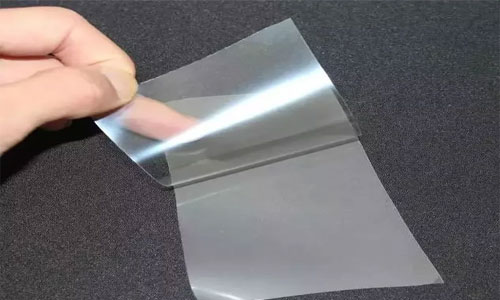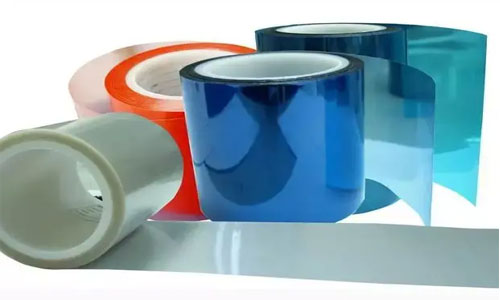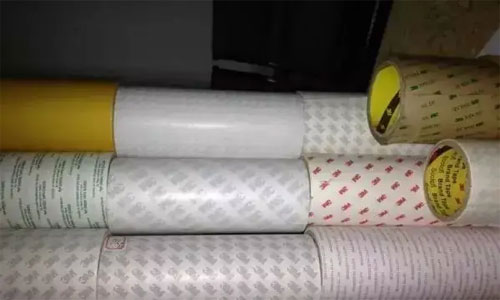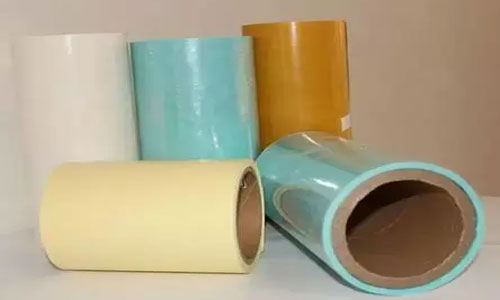There are numerous materials used for die-cutting, each with its own characteristics and purposes. Release films and release papers are commonly used in die-cutting processes, but they have distinct differences.
About Release Film
Release film is a thin layer of environmentally friendly material, such as PET, PE, or OPP, coated with silicone release agent. It exhibits a very light and stable release force with various organic pressure-sensitive adhesives.
Different types of organic pressure-sensitive adhesives, such as hot melt glue, acrylic glue, and rubber-based adhesives, require different release forces. The release force of the release film is adjusted accordingly based on the viscosity of the adhesive, ensuring a very light and stable release force during peeling.
Release films can be categorized based on different substrates, including PE release film, PET release film, OPP release film, and composite release film (composed of two or more materials).

They can also be classified by release force, such as light release film, medium release film, and heavy release film.
Different colors are available, such as red release film, yellow release film, green release film, and various colors of PET release film.
Additionally, release films can have different surface treatments, such as single-sided release film, double-sided release film, silicone-free release film, fluorine plastic release film, single-side corona treatment, double-side corona treatment, matte release film, and frosted release film.
HDPE (High-Density Polyethylene) release film is used for sealing tapes and waterproofing membranes. LDPE (Low-Density Polyethylene) release film is used for packaging mechanical products, hot melt adhesive packaging, hygiene products (diapers), and corrosion-resistant membranes. BOPP (Biaxially Oriented Polypropylene) release film is used for sealing tapes and silent tapes. PET (Polyethylene Terephthalate) release film is used for back adhesive protection. Double-sided release film includes red/green polyethylene (PE).
Double-sided release films, such as transparent PET double-sided release film, sunblock barrier films for double-sided adhesive (HDPE silver-coated film), and enhanced aluminum-based materials for waterproof membranes (BOPET), are commonly used.

About Release Paper
Release paper, also known as silicone paper or anti-stick paper, primarily functions as a barrier for sticky objects, such as tapes. It is usually peeled off and discarded after use. Its widespread applications in the food and medical industries are not discussed in detail here.
Release paper can be classified into plastic release paper and non-plastic release paper, as well as organic silicone release paper and non-silicone release paper, depending on the release agent used. Plastic release paper can also be classified based on different release agents.

To prevent the release agent from penetrating into the paper and causing curing problems or excessive release agent usage (increasing costs), release paper requires a coating process (commonly known as film coating). The coating is generally done using polyethylene (PE) particles, with a melt index of around 7. The commonly used domestic PE particles are 1C 7A from Yanshan Petrochemical. Release paper can be single-coated or double-coated. Non-plastic release paper includes specially treated other release papers like Glasing and CCK.
How to differentiate between Release Paper, Release Film, and Coated Paper
From an external appearance perspective, release films mostly appear transparent and thin, while release papers generally retain the natural color of the paper.

To distinguish between coated paper and release films of the same size, a simple test can be done using a piece of tape, a pen, and a small torn paper.
Testing method:
1. To differentiate between regular plastic film and release film, cut a piece of tape and stick it onto these materials. Then, peel it off. If it easily peels off without any sound during the process, it is a release film coated with silicone. If it is difficult to peel off and makes a squeaky sound, it is a regular plastic film without silicone coating. This method can also distinguish between single-sided silicone-coated release films and double
Let's take a look at the differences between regular plastic film and release film. Cut a piece of tape and stick it onto each of these films, then peel it off. The tape should easily come off without any sound on the release film, which is coated with silicone. On the other hand, the regular plastic film, which is not coated with silicone, is more difficult to peel off and makes a squeaky sound during the process. This method can also differentiate between single-sided silicone-coated release film and double-sided silicone-coated release film, and even compare the amount of silicone coating on each side, known as the peel-off rate.
To test with a marker, make a mark on the film surface. The marker ink will not leave any trace on the release film, while the regular film will show varying levels of ink marks. It is difficult to visually distinguish between silicone-coated paper and the same specification laminated film paper, but using the aforementioned methods can still differentiate between the two. Glossy regular paper and laminated film paper may appear similar in appearance, but if torn apart, the regular paper will only have fiber residue at the torn edge, while the laminated film paper will have small film fragments in addition to wood fibers. When testing with tape, there will be a sound during the process of peeling the tape off the laminated film paper, but the tape will not stick to anything. However, the glossy regular paper will stick to the coating on the paper surface and wood fibers.
Due to the presence of paper fibers and pulp on the surface, there is a risk of penetration when applying silicone oil. To ensure stable peel-off force, it is generally precoated before applying silicone oil (commonly known as laminating).
Special reminder: When choosing release paper, please remember to inquire about whether the raw material of the release paper is kraft paper or wood pulp paper. Kraft paper is less prone to edge breaking and has fewer paper scraps during die-cutting.
Understanding Material Combinations:
Release Film:
Silicone Release Film: Generally used in combination with acrylic adhesive, it has a good isolating effect on adhesive molecules, making it easy to peel double-sided tape off the release film.
Fluorine Release Film: Used in combination with silicone adhesive because silicone adhesive and silicone release film tend to react chemically, while fluorine can effectively isolate silicone adhesive molecules.
1) Industry matching standard 3:1 is the minimum release force ratio for mother rolls of double-sided adhesive tape production, and 5:1 is the minimum release force ratio for die-cut products. However, many people misunderstand its meaning. The release film matching ratio is based on the release force generated by the combination of each type of double-sided adhesive and release film, and it is not a universally applicable standard release force.
2) For single die-cut products with adhesive only on small areas (also known as island adhesive) less than 10 millimeters, the release force ratio of the release film should be increased.
3) The role of the release film is to isolate adhesive molecules to generate release force. However, the thicker the adhesive layer and the greater the fluidity of the adhesive, the lower the stability of the release force matching ratio. Similarly, the release film ratio should be increased.
4) To minimize the risk of reverse release without affecting customer usage, the release film matching ratio should be increased as much as possible.
The main functions of the release film are isolation, filling, protection, and easy release. Only with the use of release film can successful die-cutting be achieved due to its hardness.
Release Paper:
Adhesive manufacturers generally choose release paper with high coating weight, while laminating factories generally choose release paper with medium coating weight. For hot lamination, high coating weight release paper is also required. Water-based adhesive protection film only requires release paper with low coating weight, and release paper with medium coating weight is suitable for oil-based adhesive protection film. Release paper with high coating weight is not suitable for protection film.
Due to climate conditions, during winter, die-cutting factories should choose release paper with higher peel-off force, while during summer, release paper with lighter peel-off force is recommended. For special adhesive tapes, the release paper used during the die-cutting process should be discussed with the release coating supplier. Production activities should only be carried out after conducting thorough testing and comparison. Otherwise, it may result in a large amount of waste. However, if the requirements are not high, it is still possible to use miscellaneous paper.
Note: The provided translation is intended to capture the content and meaning of the original text.
Contact: Pamela
Phone: +86 189 6365 3253
E-mail: info@industryprocess.com
Whatsapp:+86 189 6365 3253
Add: Yajing Industrial Park, No. 59 Shuangjing Street, Weiting Town, Suzhou Industrial Park
We chat
